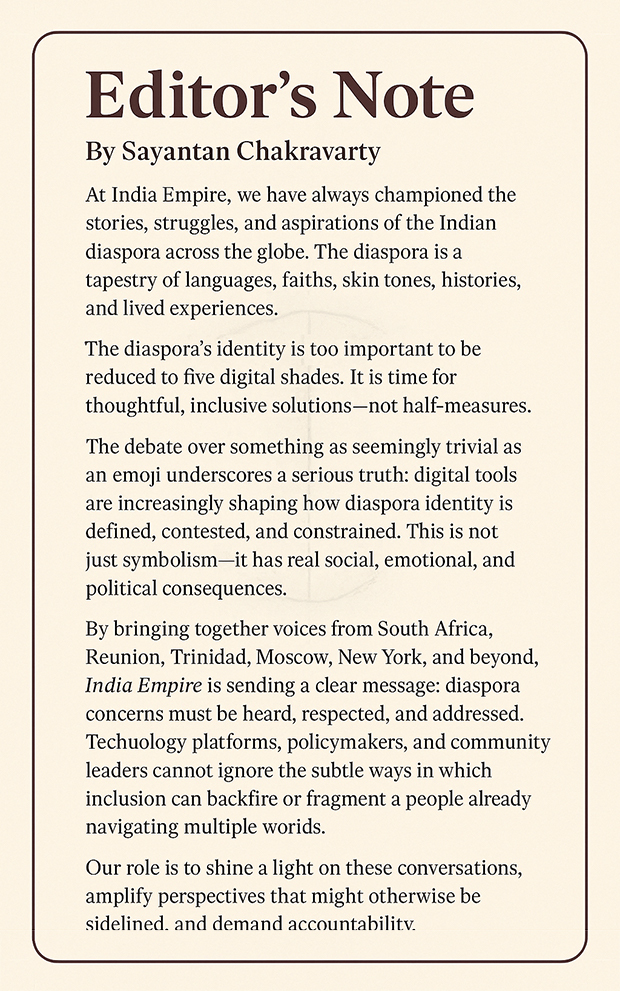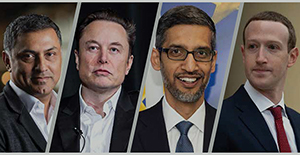DIGITAL COLOUR DIVIDE
In a hyper-connected world, even something as small as an emoji can reveal whose perspectives shape global culture—and whose remain absent. Must every gesture, whether a wave, a clap, or even a heart, carry the weight of identity?

The Diaspora’s Emotional Tax
From where I stand—as an Indian observing the diaspora with deep interest and historical awareness—it is evident that this daily prompt exacts a quiet emotional tax. Diaspora Indians are already negotiating identities across contexts, navigating everything from visa regimes to cultural expectations, microaggressions to milestones. In such a life, the emoji is not a frivolous symbol—it is another subtle site of tension.
And while this dilemma is not unique to Indians, it is perhaps uniquely complex in the Indian context, given the subcontinent’s own entanglement with colourism, caste, and colonial legacies. When that complexity is exported to global spaces, it becomes even more layered.
The trouble is, no single emoji tone can capture this depth. And perhaps it shouldn’t have to.
A Better Design, A Kinder Future
This raises important questions for the digital architects of our time: Should technology be in the business of forcing identity declarations? Must every interaction be racially coded? Is the need for representational accuracy worth the cost of daily discomfort?
Perhaps it is time for platforms to offer a neutral alternative, without prompting. A simple yellow emoji—cartoonish, cheerful, and raceless—might serve not as an erasure, but as a refuge. For many users, especially those who straddle cultures and continents, it would allow expression without categorisation, communication without the burden of constant racial signalling.
 As Dr Kumar Mahabir, Anthropologist, Editor, Publisher at the Indo-Caribbean Cultural Centre in Trinidad, suggests: “Maybe the designers should have avoided this sensitivity altogether. One option could have been to create a universal skin tone that embraces all gradations—or no skin tone at all, like a neutral sketch. But if colour was considered necessary, then why not offer the entire variation of tones, instead of forcing people into narrow categories?”
As Dr Kumar Mahabir, Anthropologist, Editor, Publisher at the Indo-Caribbean Cultural Centre in Trinidad, suggests: “Maybe the designers should have avoided this sensitivity altogether. One option could have been to create a universal skin tone that embraces all gradations—or no skin tone at all, like a neutral sketch. But if colour was considered necessary, then why not offer the entire variation of tones, instead of forcing people into narrow categories?”
We must remember: representation is powerful, but only when it uplifts. When it begins to fragment, reduce, or confine, it ceases to be a tool of progress.
As someone who publishes a magazine and books and writes about the Indian diaspora, I have long believed that its strength lies in its plurality—of language, religion, skin tone, history, and experience. To ask such a community to define itself in five digital shades is not inclusion. It is oversimplification.
Let the emoji be what it once was: a symbol of connection, not a trigger of self-consciousness. And let the Indian abroad—already navigating the weight of worlds—send a digital thumbs-up freely, while the world learns to embrace multiple perspectives, beyond Western frameworks, in how we represent ourselves and each other.
--The author is Editor and Publisher of India Empire magazine











Comments.